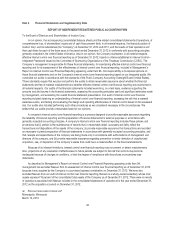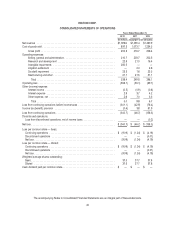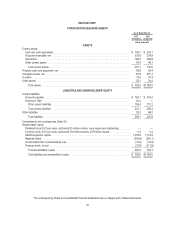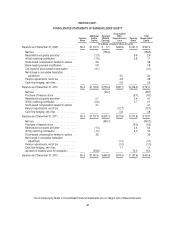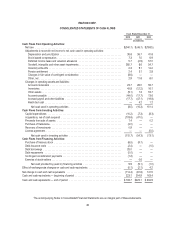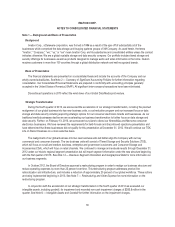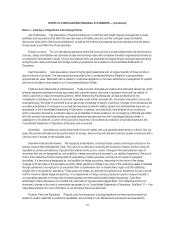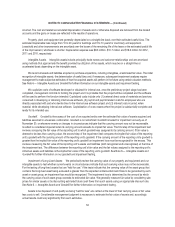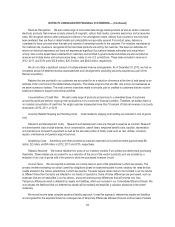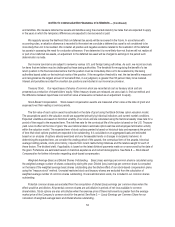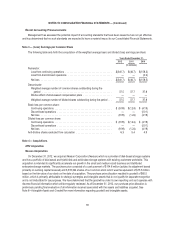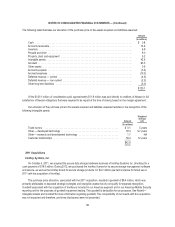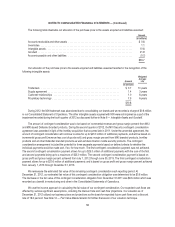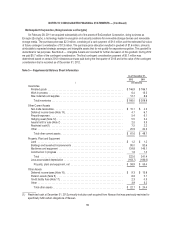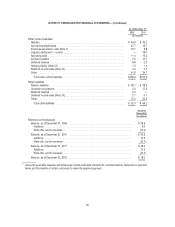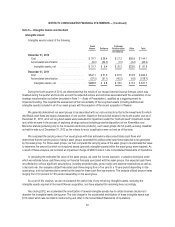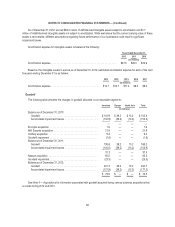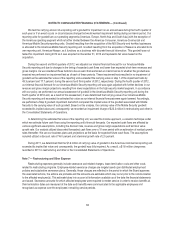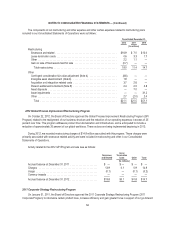Memorex 2012 Annual Report Download - page 57
Download and view the complete annual report
Please find page 57 of the 2012 Memorex annual report below. You can navigate through the pages in the report by either clicking on the pages listed below, or by using the keyword search tool below to find specific information within the annual report.NOTES TO CONSOLIDATED FINANCIAL STATEMENTS — (Continued)
and liabilities. We measure deferred tax assets and liabilities using the enacted statutory tax rates that are expected to apply
in the years in which the temporary differences are expected to be recovered or paid.
We regularly assess the likelihood that our deferred tax assets will be recovered in the future. In accordance with
accounting rules, a valuation allowance is recorded to the extent we conclude a deferred tax asset is not considered to be
more-likely-than-not to be realized. We consider all positive and negative evidence related to the realization of the deferred
tax assets in assessing the need for a valuation allowance. If we determine it is more-likely-than-not that we will not realize all
or part of our deferred tax assets, an adjustment to the deferred tax asset will be charged to earnings in the period such
determination is made.
Our income tax returns are subject to review by various U.S. and foreign taxing authorities. As such, we record accruals
for items that we believe may be challenged by these taxing authorities. The threshold for recognizing the benefit of a tax
return position in the financial statements is that the position must be more-likely-than-not to be sustained by the taxing
authorities based solely on the technical merits of the position. If the recognition threshold is met, the tax benefit is measured
and recognized as the largest amount of tax benefit that, in our judgment, is greater than 50 percent likely to be realized.
Interest and penalties recorded for uncertain tax positions are included in our income tax provision.
Treasury Stock. Our repurchases of shares of common stock are recorded at cost as treasury stock and are
presented as a reduction of shareholders’ equity. When treasury shares are reissued, we use a last-in, first-out method and
the difference between repurchase cost and fair value at reissuance is treated as an adjustment to equity.
Stock-Based Compensation. Stock-based compensation awards are measured at fair value at the date of grant and
expensed over their vesting or service periods.
The fair value of each option award is estimated on the date of grant using the Black-Scholes option valuation model.
The assumptions used in the valuation model are supported primarily by historical indicators and current market conditions.
Expected volatilities are based on historical volatility of our stock and are calculated using the historical weekly close rate for a
period of time equal to the expected term. The risk-free rate for the contractual life of the option is based on the U.S. Treasury
yield curve in effect at the time of grant. We use historical data to estimate option exercise and employee termination activity
within the valuation model. The expected term of stock options granted is based on historical data and represents the period
of time that stock options granted are expected to be outstanding. It is calculated on an aggregated basis and estimated
based on an analysis of options already exercised and any foreseeable trends or changes in recipients’ behavior. In
determining the expected term, we consider the vesting period of the awards, the contractual term of the awards, historical
average holding periods, stock price history, impacts from recent restructuring initiatives and the relative weight for each of
these factors. The dividend yield, if applicable, is based on the latest dividend payments made on or announced by the date of
the grant. Forfeitures are estimated based on historical experience and current demographics. See Note 8 — Stock-Based
Compensation for further information regarding stock-based compensation.
Weighted Average Basic and Diluted Shares Outstanding. Basic (loss) earnings per common share is calculated using
the weighted average number of shares outstanding during the year. Diluted (loss) earnings per common share is computed
on the basis of the weighted average basic shares outstanding plus the dilutive effect of our stock-based compensation plans
using the “treasury stock” method. Unvested restricted stock and treasury shares are excluded from the calculation of
weighted average number of common shares outstanding. Once restricted stock vests, it is included in our common shares
outstanding.
Potential common shares are excluded from the computation of diluted (loss) earnings per common share when the
effect would be anti-dilutive. All potential common shares are anti-dilutive in periods of net loss available to common
shareholders. Stock options are also anti-dilutive when the exercise price of these instruments is greater than the average
market price of the Company’s common stock for the period. See Note 3 — (Loss) Earnings per Common Share for our
calculation of weighted average basic and diluted shares outstanding.
54


